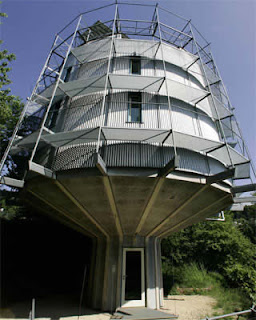Cube House (Rotterdam, Netherlands)
Living in a tilted house is much easier than it looks—just ask the people living in these the Kijk-Kubus homes. Architect Piet Blom tipped a conventional house forty-five degrees and rested it upon a hexagon-shaped pole so that three sides face down and the other three face the sky. Each of the cube houses accommodates three floors: a living space including a kitchen, study and bathroom, the middle floor houses bedrooms and the top is the pyramid room that can act like an attic or viewing deck. These houses are quite expensive, but you can satisfy your curiosity by visiting the museum show house.
Floating Castle (Ukraine)
Supported by a single cantilever --and quite discussed at Panoramio, this mysterious levitating farm house belongs in a sci-fi flick. It’s claimed to be an old bunker for the overload of mineral fertilizers but we’re sure there’s a better back story... alien architects probably had a hand in it.
Gangster's House (Archangelsk, Russia)
One-time Russian gangster Nikolai Sutyagin’s home is certainly unusual. The eccentric former convict’s seemingly accidental 15-year project begun in 1992 stands 13 floors, 144 feet high. He claims he was only intending to build a two-story house - larger than those of his neighbours to reflect hisposition as the city’s richest man.
Habitat 67 (Montreal, Canada)
Apartments connect and stack like Lego blocks in Montreal's Habitat 67. Without a traditional vertical construction, the apartments have the open space that most urban residences lack, including a separate patio for each apartment.
Heliotrope Rotating House (Freiburg, Germany)
Green to the extreme, Architect Rolf Disch built a solar powered home that rotates towards the warm sun in the winter and rotates back toward its well-insulated rear in the summer. A house that spins in circles doesn’t sound too stable to us, but for the environment it is worth the risk.
Mushroom House (Cincinnati, Ohio)
So disparate in materials and shapes this hodgepodge house looks like its been welded and glued together. But this is no hobo-construction, it was designed by the professor of architecture and interior design at theUniversity of Cincinnati, Terry Brown, and was recently on the market for an estimated $400K.
Pod House (Rochester, New York)
We assumed this oddball home was UFO-inspired, but it turns out the weed Queen Anne’s lace is where it got it's roots. Its thin stems support pods with interconnecting walkways.
Free Spirit Spheres (British Columbia, Canada)
Free Spirit Spheres can be hung from the trees as shown, making a tree house. They can also be hung from any other solid objects or placed in cradles on the ground. There are four attachment points on the top of each sphere and another four anchor points on the bottom. Each of theattachment points is strong enough to carry the weight of the entire sphere and contents.
The spheres are made of two laminations of wood strips over laminated wood frames. The outside surface is then finished and covered with a clear fibreglass. The result is a beautiful and very tough skin. The skin is waterproof and strong enough to take the impacts that come with life in a dynamic environment such as the forest.
Upside-Down House (Syzmbark, Poland)
This upside down design seems totally nonsensical–but that is exactly the message the Polish philanthropist and designer, Daniel Czapiewski, was trying to send. The unstable and backward construction was built as a social commentary on Poland’s former Communist era. The monument is worth a trip be it for a lesson in history or balance.
Wozoco Apartments (Amsterdam-Osdorp, Netherlands)
A zoning law and blueprint flub were the inspiration for this apartment complex. Dutch housing regulations require apartment construction to provide a certain amount of daylight to their tenants–but MVRDV architects forgot to plan for that. Their solution? To hang thirteen of the 100 units off the north facade of the block. The ingenious design saves ground floor space and allows enough sunlight to enter the east or west facade.










No comments:
Post a Comment